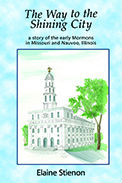
 |
The Way to the Shining City: A Story of the Early Mormons in Missouri and Nauvoo, Illinois
by Elaine Stienon
AuthorHouse
Young doctor Gabriel Romain and elder Nathaniel had moved their small family group to Far West, Missouri, following Joseph Smith’s leadership after neighbors evicted the Mormons. New cabins were built, babies were born, young men and women married, and a southern slave escaped to join her freed husband. Even in Far West, pride, jealousy, and childlessness ate away at the family’s peace.
Rumors accuse the Mormons of polygamy, and Missourians respond aggressively. All Mormons must now flee again, even those who practice monogamy like Gabriel and Nathaniel. Most cross the river by ferry to Nauvroo, Illinois, and contribute toward building the temple of that shining city. Joseph Smith’s run for President can’t overcome Mormon prejudice; he is assassinated. New leaders declare that all Mormons rely on faith for healing, not doctors. Gabriel knows that Smith did not advocate such teachings. Should his small family hide on the Missouri side of the river with Nathaniel, follow Brigham Young across the Rockies, or follow James Strang to Wisconsin? Dangerous times force all to decide their path.
In this 289-page novel, the author uses her extensive historical research to document persecution of the Mormons by their non-Mormon neighbors during the mid-1800s. She engages the reader by telling the story from the viewpoints of French Huguenot and Quaker converts who were inspired by Joseph Smith’s evangelism to join the Mormons. From that perspective, portrayals of Mormon leaders in the book are understandably secondhand. The author reports eye-witness accounts of trouble against the Mormons as told by characters within the story. The short sentences and different tense used imply a sense of urgency. Stienon’s historical research—likely from diaries and newspapers—provide the reported information but are not documented in a list of resources. However, the technique of quoting from a fictional diary cleverly brings to life Dr. Gabriel Romain.